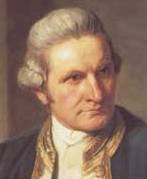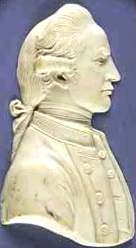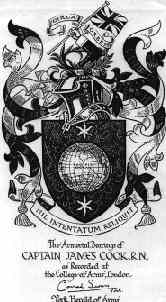|

Captain
James Cook
Captain James
Cook "...
the ablest and most renowned navigator this or any
country hath produced. He possessed all the
qualifications requisite for his profession and great
undertakings ..."
-
Lord Palliser, Cook's superior in the Navy.
On
April 3, 1768, the Earl of Pembroke, an ungainly-looking
North Sea coal carrier, was put into dry dock in a
choice slip at the English Naval shipyard of Deptford,
on the Thames River near London. Stout and
heavy-timbered, with a bluff bow and a narrow stern, the
new arrival appeared distinctly out of place amid the
rows of sleek frigates and towering ships of the line
being repaired and refitted for duty. A few Deptford
officers brusquely questioned whether the bark-rigged
vessel was even mustered in the Royal Navy. For what
conceivable purpose could the Admiralty require the
services of a grimy workboat?
In
fact, the humble collier was intended for a singularly
adventurous role. She would carry a hand-picked group of
naval officers and scientists to the farthest reaches of
the Pacific to conduct vital astronomical studies and to
make yet another search for the continent identified on
the maps as Terra Australis Incognita. A collier had
been selected because it could hold the large quantities
of supplies and scientific equipment the voyagers would
require, and also because it was flat-bottomed and was
able to take the punishment of an accidental grounding.
On
April 5 the Admiralty renamed the vessel Endeavour and
ordered the Deptford carpenters to prepare her for the
journey with the greatest dispatch. Within four weeks
her hull had been sheathed with a second layer of
planking to protect against tropical sea worms. Her
masts and yards were scrapped for fresh-cut spars, and
all her rigging was replaced with new hempen lines. On
May 18 the ship was refloated and moored in the great
Deptford Basin, alongside the mighty warships of the
British Empire, to await the arrival of her commander.
To
some Londoners the selection of Lieutenant James Cook as
leader of the expedition to the Pacific was even more
surprising than the Admiralty's choice of the Endeavour.
At the age of 39, Cook was virtually unknown to his
countrymen. In marked contrast to Commodore John Byron
and Captain Samuel Wallis, the aristocratic leaders of
England's earlier voyages of Pacific exploration, Cook
sprang from the lower ranks of society, was haphazardly
educated and had not even spent his whole career in the
Royal Navy: His training had been in the merchant
marine.
But,
like the Endeavour, James Cook possessed exactly those
qualities deemed crucial by the Admiralty for the
success of the job at hand. For four years, beginning in
1763, Cook had sailed the rugged coast of Newfoundland,
charting its bays and inlets with painstaking precision.
More than once he had earned praise from the highest
levels of the Navy for his surveying work and superb
seamanship, and the Lords of the Admiralty reasoned that
the talents that had been so valuable in the
Newfoundland enterprise would be equally useful in the
uncharted waters of the South Pacific. As it turned out,
Cook would become the greatest explorer of his time -
and the greatest Pacific explorer of all time.
As
captain of the Endeavour, he would sight and survey
hundreds of landfalls that no Westerner had ever laid
eyes on. And though the Endeavour would never fire her
guns at another ship in battle, Cook's epochal voyage
aboard the converted collier was destined to bring under
George III's sovereignty more land and wealth than any
single naval victory of the powerful British fleet. But
the most important prize of this and the two subsequent
voyages that Cook would make was measured not in
territory but in knowledge. Patient and methodical where
his predecessors had been hasty and disorganized, he
would sweep away myths and illusions on a prodigious
scale, and in the end would give to the world a
long-sought treasure: a comprehensive map of the
Pacific.

The Earl of Pembroke
After
three voyages in the 'Freelove', Cook took part in
rigging and fitting out a new ship of Walker's called
the 'Three Brothers'. Signing on after his
apprenticeship had expired, he remained in the ship
until 1752, apart from a voyage to the Baltic in the
'Mary', when he sailed as far as St. Petersburg. In 1752
he passed the examinations to become mate and joined
Walker's latest ship, the Friendship, sailing in her for
three years. By 1755 Cook was an experienced and
trustworthy seaman, and John Walker offered him the
command of the ship.
But Cook had other plans. In June 1755, he left Whitby
and volunteered as an ordinary seaman in the Royal Navy.
The only explanation he gave was that: "I
had a mind to try my fortune that way."
Walker was surprised and disappointed, but nonetheless
continued to assist Cook and remained his life-long
friend. Cook signed on and for two years served in HMS
Eagle. Within a month he was promoted to master's mate,
the same rank he had held in Walker's ships
In
1762 he married Miss Elizabeth Batts of Shadwell, who
had close links with the Quaker community in London with
which Walker did much business. Cook was thirteen years
older than his wife. They spent only four months
together before Cook went back to sea. This was to be
the pattern for much of their married life.
Cook's naval experience included service on the North
American station, where he saw action against the French
during the Seven Years War. He learnt the techniques of
surveying and charting coastal waters and had the good
fortune to observe and record an eclipse of the sun,
which he reported to the Royal Society in London.
This was no doubt remembered at the Admiralty in 1768
when their Lordships decided to dispatch a ship with
members of the Royal Society to observe from Tahiti the
transit of Venus across the sun. Cook was chosen in
preference to others who had served longer in the Navy.
He was offered the command of the Endeavour and given
the rank of lieutenant.
He
was also very familiar with the type of vessel chosen by
the Admiralty. The Endeavour was a Whitby-built collier,
solidly built, able to withstand being run aground,
capacious and able to carry many provisions. The ship
could also be managed by a small crew if necessary.
According to Cook, "a
better ship for such service I never could wish for."
So Cook and a Whitby ship came together again in the
Endeavour to lay the foundation for one of the most
significant voyages in the history of exploration.

Stone portrait
Captain
James Cook possibly the most renowned mariner in
history, sailed from Plymouth in 1776 in the HMS
“Discovery” and HMS “Resolution” to search
for a northeast or northwest passage. Aboard the
“Discovery” was Charles Clerke as captain and a
young midshipman named George Vancouver. Cook was
captain of the “resolution”, while a brilliant
seaman, William Bligh was master.
Cook headed for the west coast of the American continent
of “New Albion” on 2 February 1778. Five days later,
land was sighted. Weather drove the ships out to sea and
a week passed before land was seen again. With both
vessels in need of repair, Cook entered into Nootka
Sound on the western side of Vancouver Island (later
named by Vancouver himself).
They were met by Haida Indians in forty-foot long
dug-out canoes immediately seeking trade. Anything of
iron was traded for furs and fish. Cook believed a
profitable market could be established. Carpenters and
Blacksmiths went ashore and set to work repairing the
“Resolution”.
Captain James Cook was the foremost explorer of his age.
It is nearly impossible to overstate his contribution to
geographical knowledge. On this voyage, the French
discoveries southeast of the Cape of Good Hope were
verified, Hawaii was discovered with other islands on
the Sandwich Group in the North Pacific, and much of the
northern coast of the Pacific Ocean was explored and
charted.

Cook's
coat of arms
The coat
of arms is that of Captain James Cook, the Navigator. It
was awarded posthumously by the King of England and is
the only one ever to include a globe (centered on the
Pacific Ocean) and Polar stars. The motto reads:
"He left nothing unattempted". I am personally
linked to him through my mother's side of the family, as
one of her ancestor's married his sister Margaret. This
union caused him to become my Great, Great, Great, Great
Uncle.
For those
not familiar with the Captain, he first came to the
attention of the British Admiralty during the conflicts
with France for the possession of Canada. His Highly
detailed charts of Canadian rivers and coastlines helped
the British Fleet to launch successful Attacks on
several French Strongholds and ultimately win the war
there.
Later, he
was selected to command several long expeditions to
search for the rumored "Northwest Passage",
observe the transition of Venus (from Tahiti) and to
search for the "Great Southern Continent",
which scientists in those days believed must exist in
order to "Balance the Earth"! Along the way,
he added a large number of new places to the World Map,
including the Islands of Hawaii, which he was the first
European to discover.
His
remarkable voyages of exploration came to an abrupt end
when, due to an unfortunate misunderstanding with his
former Hosts, he was killed trying to prevent his men
from firing at an angry crowd of Hawaiians. Later on,
when tempers cooled, his remains were returned to his
crew and he was buried at sea. A Naval Warship from
Great Britain stops by each year to take care of his
memorial near Kona on the 'Big Island' of Hawaii. The
small white obelisk stands on one of the only two pieces
of Sovereign Territory left in America¹.
Cook
didn't find the fabled "Great Southland", but
he discovered - in Australia - a country equally
deserving of such a title! It is worth mentioning
here that a piece of his original ship
"The Endeavour", a converted coal-carrier, was
taken into orbit aboard the Space-Shuttle
of the same name.
CAPTAIN
JAMES COOK LINKS
GENERAL
HISTORY
MARITIME
HISTORY

Solar
Cola a taste for adventure
|